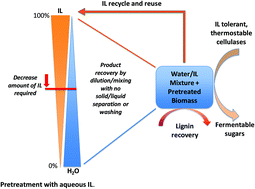Understanding the role of water during ionic liquid pretreatment of lignocellulose: co-solvent or anti-solvent?†
Abstract
Biomass pretreatment with certain ionic liquids (IL) can be highly effective at generating a substrate that can be easily saccharified into fermentable sugars with high yields. In order to improve overall process economics, using mixtures of these ILs with water are more favored over the use of anhydrous IL; however, the solvent property of IL–water mixtures and correlations between cellulose digestibility, cellulose solvation and lignin depolymerization during IL–water pretreatment of lignocellulosic biomass are not well understood. We investigated pretreatment of switchgrass with mixtures of 1-ethyl-3-methylimidazolium acetate, [C2mim][OAc], and water at 160 °C. Results indicate that the chemical composition and crystallinity of the pretreated biomass, and the corresponding lignin dissolution and depolymerization, were dependent on [C2mim][OAc] concentration that correlated strongly with cellulose digestibility. In addition, the hydrogen bond basicity of the [C2mim][OAc]–water mixtures was found to be a good indicator of cellulose dissolution, lignin depolymerization, and sugar yields. Molecular dynamics simulations provided molecular level explanations on cellulose Iβ dissolution at different [C2mim][OAc]–water loadings. The knowledge gained from this study provides a better understanding of the duality of water as a co-solvent/anti-solvent in dissolving cellulose and serves as a design basis for the targeted design of IL–water mixtures that are effective at biomass pretreatment.


 Please wait while we load your content...
Please wait while we load your content...